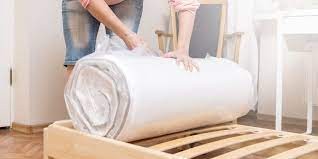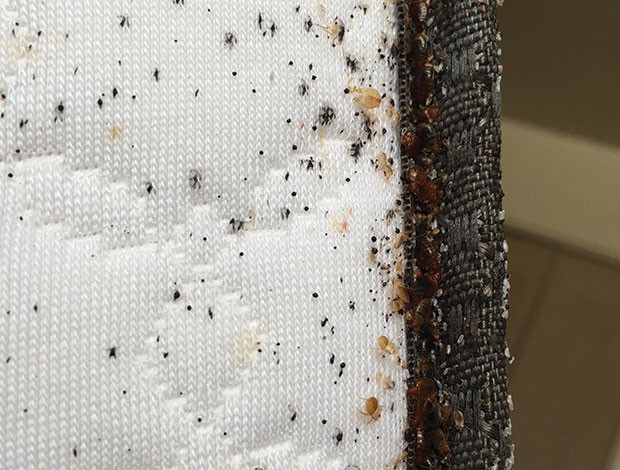Bed bugs prefer hiding on your bed so they can easily reach you. This puts your mattress and other bedding, such as pillows and bed sheets, at a high risk of infestation. Bites from these vampiric bugs can turn your life into a living nightmare; hence you need to implement some preventative measures.
Using plastic mattress encasements is one of the many tactics people use to keep themselves safe from bed bugs. This post explores the truth about plastic mattress encasements and whether or not they can help in your fight against bed bugs.
Table of Contents
What Is A Plastic Mattress Encasement?
A plastic mattress encasement is a barrier that covers every part of your mattress. Unlike mattress protectors and mattress covers, encasements cover the mattress on all sides and prevent bed bugs from hiding inside.
Bedbug mattress encasements are polyethylene-based (also named polyester) or vinyl. They also have a zipper to seal them and keep bedbugs out of your mattress.
Encasements can protect your mattress from bed bugs but are also applicable against various contaminants, including dust mites, moisture, mold, mildew, and pet dander.
When Does A Plastic Mattress Encasement Help Against Bed Bugs?
Plastic mattress encasements tend to offer a range of options in your war against bed bugs. A plastic mattress encasement can help when your mattress has bed bugs and when you hope to keep bed bugs away from your mattress. Either way, bed bug-proof plastic wraps can be a great arsenal in fighting an infestation.
If your mattress already has bed bugs, a plastic mattress encasing will save you from bed bug bites by preventing the bed bugs from escaping the mattress and accessing you. It traps the bed bugs inside the mattress, effectively preventing them from reaching you. You will have to encase the mattress fully in plastic for adequate protection.
On the other hand, if you are lucky to have a bed bug-free mattress, a plastic encasement is still an excellent idea for preventing infestation. Plastic covers eliminate countless hiding spots on your mattress that bed bugs can use to hide. It also prevents bed bugs from accessing the mattress from outside. Besides, in case of a heavy infestation, it is cheaper to throw away a plastic encasement than a mattress.
Can Bed Bugs Live In A Plastic Mattress?
As the history of bed bugs shows, they are so good at surviving that they can live in plastic mattress encasements. However, plastic mattresses are not as comfortable or suitable as fiber or other fabrics. Bed bugs tend to love moist and dark environments to hide and breed. Citing an expert report, a Pestkeen post notes that plastic, unlike most fabrics, creates a dry and airless surrounding that will desiccate or suffocate the bed bugs.
It will also do you good to remember that the effectiveness of a plastic encasement will depend on whether you placed it correctly, the quality of the encasing or zipper, or whether there are holes and tears in your encasing. Ideally, the encasement should be tight, sealed, and bed bug-proof. If the bed bugs can still access your mattress, they can live and multiply inside, which beats the whole purpose of the plastic encasing.
Do bed bugs die in Plastic Covers?
Like other living things, bed bugs must feed and breathe fresh air. A quality plastic mattress encasing denies them access to food and oxygen. As good at surviving as bed bugs are, they can only live for so long without feeding on blood. An engorged bed bug can live for up to five months before needing blood again. Nevertheless, the bed bugs trapped inside your mattress encasement cannot multiply because nymphs need to feed to move to the next stage of the bedbug’s lifecycle.
If your mattress has bed bugs, keep the plastic encasing in place for more than five months to starve these bugs effectively. It would be best if you also remember that bed bug eggs can survive even longer before hatching. Take caution when removing the covers, and always ensure to regularly check and treat for bugs.
It may be difficult to kill bed bugs by suffocation as they do not require much oxygen. Their anatomies are adapted to survive under low oxygen concentrations. Plastic mattress covers are not entirely airproof. It is not an option to kill bedbugs as the air in the plastic encasement is enough to sustain them for a longer time.
Can Bed Bugs Go through Your Plastic Mattress’s Zipper?
Bed bugs have flat bodies enabling them to go through small cracks, crevices, and tears in different fabrics. This body adaptation makes them hard to crush, and they can survive a squeeze, especially if they haven’t been fed. Nonetheless, they cannot go through zippers to infest your mattress as tiny and flattened as they are.
Whether metal or plastic, Zipper teeth are usually designed to interlock tightly when the slider passes through. The zippers are also well stitched to the plastic encasement to prevent even tiny pests from going through. So rest assured that bed bugs cannot go through the zippers. However, this rule still has exceptions, for example, a faulty worn-out zipper that does not close well or thoroughly. This will let these critters into your mattress for infestation.
When to use plastic mattress encasements
You do not need to see bed bugs to do something. Prevention is better than cure because eliminating an infestation is more costly than actually treating one. It is here that plastic mattress covering comes into play. A plastic encasing can help save your money by preventing the likelihood of having to buy a new mattress.
You may be moving to a new location and are worried about sleeping on a bedbug-infested mattress. The good thing about plastic mattress encasements is that you can fold them and carry your plastic encasing anywhere. It not only seals bed bugs in but also makes it easier to exterminate bed bugs in the surrounding without ruining the mattress.
What to Do if You Find Bed Bugs in Your Plastic Mattress Encasement
Bed bugs may find a way into your plastic mattress encasement. This is depressing, but you do not need to panic and subsequently make mistakes when getting rid of the bed bugs. Depending on the size of the infestation, you will have to handle it carefully.
Once you have spotted an infestation, treatment is a little easier, owing to the plastic encasing. The plastic material makes it easier to treat an infestation. Also, it is easier to spot bed bugs on a plastic encasing than on a mattress or wood as they tend to camouflage to the surrounding. Conventional methods like steaming, vacuuming, or washing in scalding water will likely manage the problem for you.
We also recommend using essential oils, natural oils, and silica gel to manage small infestations. It will, however, depend on whether the bed or surrounding has bed bugs. It would be best to be careful when handling heat around plastic as it tends to melt and ruin your mattress.
A massive infestation calls for an equally huge fight. If you are unlucky and the infestation on your mattress cover has grown exponentially, you may have to make sacrifices that you may not be comfortable with. Throwing out an infested mattress cover is more practical than a mattress. As costly as it sounds, a new plastic cover is worth it as it guarantees a goodnight’s sleep.
Final Thoughts
Investing in quality plastic encasing may save you the cost, pain, and embarrassment of a bed bug infestation. Nevertheless, even with the best mattress encasements, you must take steps to prevent infestations. Some standard preventative measures include:
- Deploying bed bug monitoring tools around your home
- Reducing clutter in your home
- Sealing cracks and crevices in your home
- Take steps to avoid getting bed bugs in hotels, movie theatres, and other public spaces
FAQs
Can you get bed bugs if you have plastic on your mattress?
Yes. You still can get infested with bed bugs, even with a plastic mattress. Plastic encasement will only prevent the infestation from getting into your mattress.
Can bed bugs get through the plastic cover?
Yes. Invest in quality covering that will prevent bed bugs from infesting your mattress. Old, worn-out, and torn plastic covering may let bed bugs into your mattress.
Do plastic mattress covers prevent bed bugs?
No. Plastic covers provide uncomfortable conditions that reduce the chances of getting infested with bed bugs. They do not kill or repel bugs.
Can bed bugs die underneath a plastic mattress cover?
Yes. Despite being resilient, bed bugs still need to feed to live and reproduce. On a long enough timeline, bed bugs sealed inside plastic mattress encasements will starve to death.


